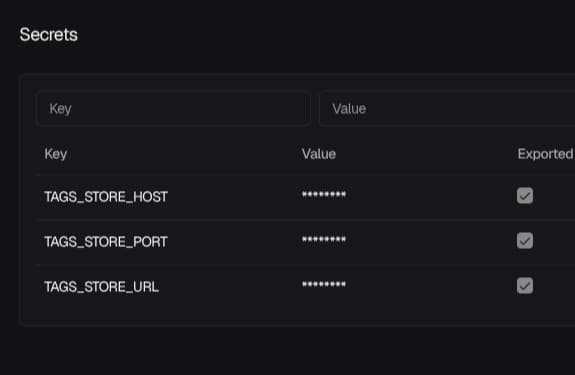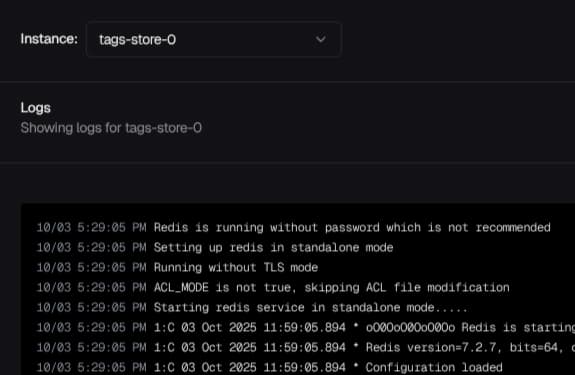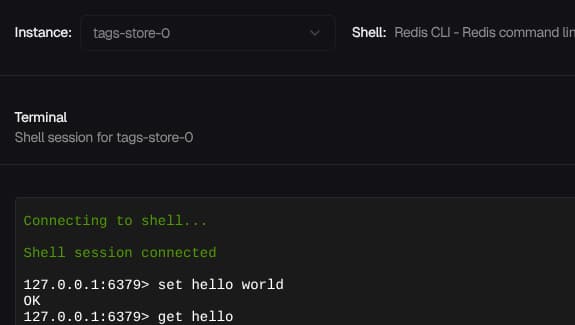High-performance caching without the burden
Deploy production-ready Redis caches in minutes. Zero maintenance, automatic clustering, built-in replication. Accelerate your applications without managing infrastructure.
Speed up your apps without becoming a caching expert
Traditional cache deployments force you to master clustering, replication, failover, and memory optimization. Flash handles all the complexity while you focus on performance.
Complex clustering setup
Manual replication management
Performance tuning overhead
From configuration to production in three steps
Flash streamlines cache deployment. No complex setup, no caching expertise required.
Choose your cache engine
Select Redis and configure your memory and compute resources. See real-time cost estimates as you build your configuration.
Enable clustering & replication
Turn on clustering for horizontal scaling or replication for high availability with simple toggles. No manual configuration required.
Deploy and accelerate
Launch your cache cluster. Automatic monitoring, failover, and scaling handle the rest.
Enterprise-grade caching features built-in
Every Flash cache comes with production-ready capabilities out of the box. No plugins, no add-ons, no complex configuration or caching expertise required.
Sub-millisecond latency
In-memory performance for the fastest possible data access. Accelerate your application response times dramatically.
Automatic failover
Built-in high availability with automatic failover. Your cache stays online during failures without manual intervention.
Cluster support
Horizontal scaling through automatic sharding. Distribute your data across multiple nodes with zero configuration.
Built-in replication
Automatic primary-replica setup. Data replication configured automatically for high availability.
Seamless scaling
Scale memory and compute resources without downtime. Adapt to changing performance demands effortlessly.
Enterprise security
Encrypted in transit with network isolation. Access controls and security patches managed automatically.
Redis - The world's most popular in-memory data store
Flash currently supports Redis, with Memcached and Valkey coming soon. Get all the power of Redis without the operational complexity.
Redis
High-performance in-memory data structure store for caching, session storage, and real-time analytics.
Multiple data structures
Strings, lists, sets, sorted sets, hashes, bitmaps, and more. Flexible data modeling for any use case.
Pub/Sub messaging
Built-in publish-subscribe capabilities for real-time messaging and event-driven architectures.
Transactions & Lua scripts
Atomic operations and server-side scripting for complex caching logic without round trips.
TTL & eviction policies
Automatic expiration and intelligent eviction strategies to optimize memory usage.
Persistence options
Optional disk persistence (RDB/AOF) for cache durability and faster restarts.
Stream processing
Redis Streams for append-only log data structures and real-time data processing.
Coming Soon
Memcached
Q2 2026
Valkey
Q2 2026
Clustering without the complexity
Scale your cache horizontally with automatic sharding. Flash handles cluster topology, node management, and data distribution—you just set the number of nodes.
Automatic sharding
Data automatically distributed across cluster nodes. Hash slots managed transparently for optimal performance.
Zero-downtime resharding
Add or remove nodes without service interruption. Data rebalancing happens seamlessly in the background.
Smart client routing
Clients automatically discover cluster topology and route requests to the correct nodes.
High availability per shard
Each shard can have replicas for redundancy. Node failures handled automatically without data loss.
Every caching need
Lightning-fast user sessions
Store user session data in-memory for instant access. Handle millions of concurrent sessions with automatic scaling.
- ✓Sub-millisecond session retrieval
- ✓Automatic TTL for session expiry
- ✓High availability with replication
Reduce database load dramatically
Cache expensive database queries and API responses. Serve repeated requests instantly without hitting your database.
- ✓Configurable cache invalidation
- ✓Dramatic latency reduction
- ✓Lower infrastructure costs
Fast counters and aggregations
Track real-time metrics, leaderboards, and analytics data. Update and query at high speeds without database overhead.
- ✓Atomic increment/decrement operations
- ✓Sorted sets for rankings
- ✓Pub/Sub for live updates
Caching tools that just work
Connection strings
Connection strings generated automatically and injected into dependent services. No manual configuration, no copy-pasting credentials—your applications just work.


Real-time logs
Stream logs from your entire cache fleet through a unified interface. Debug cache issues across all nodes instantly—no SSH-ing into multiple servers or parsing scattered log files.


Shell access
Access the Redis CLI for any node in your cluster from a single interface. Run diagnostics, inspect keys, and troubleshoot without managing SSH keys or bastion hosts.


Replication that works automatically
Built-in primary-replica replication ensures your cache stays available during failures. Automatic failover promotes replicas seamlessly—no manual intervention required.
Automatic replica promotion
When primary nodes fail, replicas are promoted instantly. Your applications stay online without service interruption.
Synchronous replication
Optional synchronous replication for zero data loss scenarios. Balance between consistency and performance.
Read scaling
Route read operations to replicas for improved performance. Distribute query load across multiple nodes.
Continuous health monitoring
Proactive monitoring detects issues before they impact your application. Automated recovery minimizes downtime.
Start free, scale as you grow
Launch your first cache completely free with 125m CPU, 512MB RAM, and 5GB storage. No credit card required. When you're ready to scale, pay only for resources with no hidden fees.
Resource-based pricing
Pay for memory and CPU only. No per-request fees or data transfer charges within your project.
No caching expert needed
Save on hiring Redis specialists or consultants. Flash handles all optimization and tuning automatically.
Cost-effective scaling
Start small and scale as you need. Only pay for the resources you actually use, no overprovisioning required.
Built on enterprise-grade infrastructure
Memory & Compute
Availability
Performance
Data Management
Accelerate your application today
Join teams who've eliminated caching complexity and improved performance with Flash.
Frequently asked questions
Do I need Redis expertise to use Flash?
No! Flash is designed to eliminate the need for caching expertise. All configuration, clustering setup, replication management, and optimization are handled automatically. You can focus on using cache to improve your application while Flash handles the operational complexity.
How does clustering work?
Flash provides automatic clustering with sharding across 3-9 nodes. Data is distributed automatically using hash slots, and the cluster topology is managed for you. You simply choose the number of nodes, and Flash handles all the complexity of cluster coordination, node discovery, and data distribution.
What happens during a node failure?
Flash continuously monitors all cache nodes. If a primary node fails, a replica is automatically promoted within 10 seconds. Your application's cache connections are maintained, and there's minimal data loss with replication enabled. The system self-heals without manual intervention.
Can I use my existing Redis client libraries?
Yes! Flash is fully compatible with the Redis protocol. Any standard Redis client library works seamlessly—just update your connection string. No code changes required, and all Redis commands and features are supported.
How does memory eviction work?
Flash supports all standard Redis eviction policies (LRU, LFU, random, TTL-based). You can configure the policy that best fits your use case. The system automatically manages memory and evicts keys according to your chosen policy when memory limits are reached.
What's the difference between clustering and replication?
Clustering distributes data across multiple nodes for horizontal scaling (more capacity and throughput). Replication creates copies of data on secondary nodes for high availability (failover protection). You can use both together—clustered shards with replicas for each shard.
Can I persist cache data to disk?
Yes! Flash supports optional persistence with both RDB (snapshots) and AOF (append-only file) modes. This allows faster restarts and can protect against data loss, though it comes with a small performance trade-off. Most caching use cases don't need persistence.
How do I monitor cache performance?
Flash provides real-time metrics including hit rates, memory usage, throughput, and latency. You can track cache effectiveness and identify performance bottlenecks through the dashboard. Detailed analytics help optimize your caching strategy.
When are Memcached and Valkey coming?
Memcached and Valkey support are planned for Q2 2026. We're starting with Redis to deliver the best possible managed cache experience, then expanding to support more cache engines based on user demand.